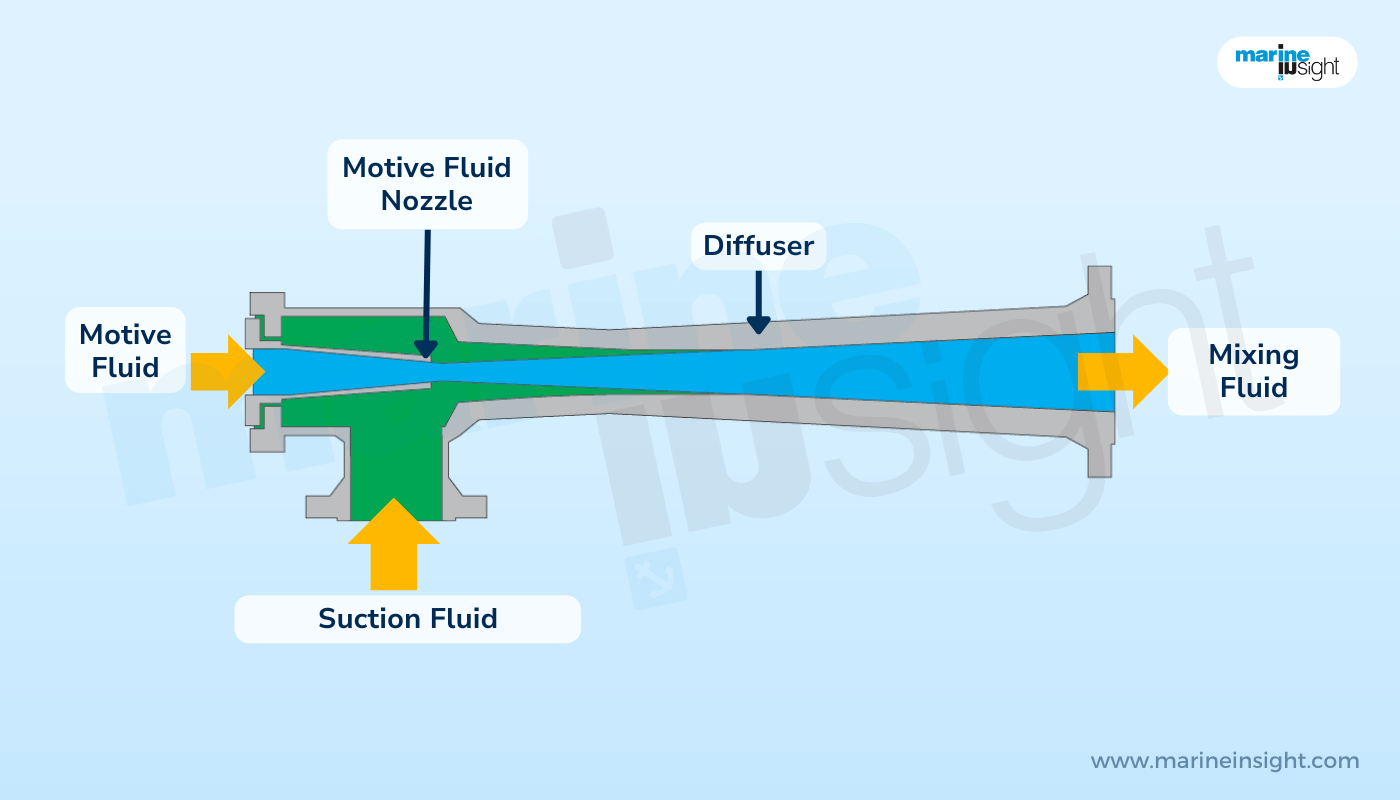What is Eductor On a Ship?

An eductor is a simple version of a pump used to move a liquid form of a fluid out of a certain place.
However, unlike more complex versions of pumps, they do not have any mechanised components or moving parts that create an external force to transport a certain quantity of water. Instead, they rely on the simple theory of Bernoulli’s principle and a specific case of this, the Venturi effect.
What is Bernoulli’s principle?
As we know from the classical theory of fluid mechanics, Bernoulli’s principle states that a change in fluid velocity is marked within any system due to the pressure differential of the incompressible fluid or any change in the potential energy.
A Venturi effect is a specific case of this principle wherein there is a reduction or drop in fluid pressure and a consequential gain in the fluid velocity (from the fundamentals of fluid continuity) when it passes through a reduced cross-sectional area or a partial obstruction in its flow path.
In other words, any change in speed that a volume of fluid (and a resultant increase in kinetic energy) may attain while passing through changing cross-sectional areas in its path amounts to a proportional drop in static pressure head.
A venturi meter is a demonstrative representation of this effect. In it, a fluid is made to pass through a certain tube that is tapered midway, resulting in a decreased cross-sectional area. This changing area increases the fluid’s velocity and kinetic energy, accompanied by a sudden decrease in static pressure reflected in the water columns, as shown in the standard arrangement below.
Eductors use this principle, making them known as jet pumps. They essentially use the suction effect that arises due to the pressure drop stemming from Venturi action and, in turn, help strip off or transfer fluid from another source into another location.
The working of an eductor is pretty simple. A driving or motive incompressible fluid is made to enter through a tapering inlet nozzle. This fluid is drawn from another pump or a flow source.
When the fluid exits this nozzle, owing to the decreased cross-section and consequential rise in flow velocity, there is a decrease in pressure. This low-pressure, high-velocity fluid enters into another chamber. Now, in the wake of the low-pressure zone created by the fluid, the subject or other body of fluid is drawn in from another inlet opening into the system. For the suction fluid to be drawn in, the pressure created in the wake of the driving fluid has to be lower than this.
Energy transfer occurs as these two fluids get mixed up in the throat section. The suction fluid gets entrained into the driving fluid and gains kinetic energy. The mixture gets transferred to the diffuser section, where the area increases again. The resultant velocity decreases, and the pressure energy increases again. The resultant fluid now gets ejected at a definite outlet.
For all practical purposes, the suction and driver fluid in the eductor’s areas of application are mostly the same: water.
Eductors are used in ships for a variety of purposes. Some of them are:
- Stripping cargo oil tanks while loading/unloading operations
- Removing sludge from tanks like fuel oil, lube, or dirty oil tanks.
- Dewatering of cargo types like coal, sand, cement, stone, etc.
- Cleaning of various spaces in the vessel, ballast tanks, and draining deck areas in events of water accumulation.
In ships, eductors are continuously operated at higher pressures as desired.
One very important practice that needs to be kept in mind during shop operations is that the valves and screws from the suction line need to be opened only after the driving or motive fluid line is started. This is to prevent accidental flow of driving fluid into the tankage or other spaces from where the liquid is required to be sucked.
Moreover, if, on some occasions, the driving pressure falls below a certain level, the valves near the suction area lines need to be closed to prevent the flow of the driving fluid in the other area, as this creates a problem.
For example, when you intend to strip or drain an oil tank with an eductor, if the driving fluid, water, operates at a lower pressure and backflows into the tank, it gets mixed further with the oil or sludge content.
However, for all practical purposes, the valves and stoppers in the suction line are kept mostly open, as even when the suction fluid has reduced inflow velocity, it goes back to its source. It can be re-drawn back again after necessary pressure adjustments to the eductor. But if the backflow of this line is stopped during high-flow rate operations, there is a chance of excess pressure build-up and the eductor collapsing or bursting.
For all practical purposes, the drained contents from the eductor during tank stripping operations are collected into sludge or slop tanks, where they are discharged at very high rates through electrically driven pumps. During operations like deck de-flooding, the eductor outlet is connected directly to a discharge line from where it is drained into the sea.
You might also like to read-
- Understanding Water Jet Propulsion – Working Principle, Design And Advantages
- Selective Catalytic Reduction (SCR) Reactors For Ships – Types, Working Principle, Advantages And Disadvantages
- Understanding the Principles of Passage Planning
- Understanding Marine Sextant – Principle, Readings and Maintenance
Disclaimer :
The information contained in this website is for general information purposes only. While we endeavour to keep the information up to date and correct, we make no representations or warranties of any kind, express or implied, about the completeness, accuracy, reliability, suitability or availability with respect to the website or the information, products, services, or related graphics contained on the website for any purpose. Any reliance you place on such information is therefore strictly at your own risk.
In no event will we be liable for any loss or damage including without limitation, indirect or consequential loss or damage, or any loss or damage whatsoever arising from loss of data or profits arising out of, or in connection with, the use of this website.
Do you have info to share with us ? Suggest a correction
Disclaimer :
The information contained in this website is for general information purposes only. While we endeavour to keep the information up to date and correct, we make no representations or warranties of any kind, express or implied, about the completeness, accuracy, reliability, suitability or availability with respect to the website or the information, products, services, or related graphics contained on the website for any purpose. Any reliance you place on such information is therefore strictly at your own risk.
In no event will we be liable for any loss or damage including without limitation, indirect or consequential loss or damage, or any loss or damage whatsoever arising from loss of data or profits arising out of, or in connection with, the use of this website.

About Author
Subhodeep is a Naval Architecture and Ocean Engineering graduate. Interested in the intricacies of marine structures and goal-based design aspects, he is dedicated to sharing and propagation of common technical knowledge within this sector, which, at this very moment, requires a turnabout to flourish back to its old glory.
Latest Marine Technology Articles You Would Like:
- 10 Harmful Effects Of Impure Air On Ship’s Machinery
- 10 Important Things to Check While Starting Fuel Oil Purifier on Ships
- 10 Noteworthy LNG-Powered Vessels
- 10 Points for Efficient Turbocharger Operation On Ships
- 10 Practical Tips to Handle Engine Room Pumps
- 10 Precautions to Take Before Operating Controllable Pitch Propeller (CPP) on Ships
Subscribe To Our Newsletters
By subscribing, you agree to our Privacy Policy and may receive occasional deal communications; you can unsubscribe anytime.















